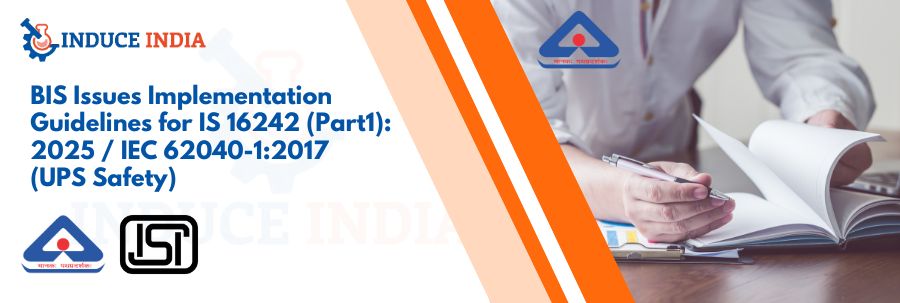BIS has recently published the implementation guidelines of IS 16242 (Part 1):2025, a standard that corresponds to the IEC standard of 62040-1:2017 of the international standard of the Uninterruptible Power System (UPS) safety. This will be a step toward making sure that UPS equipment in India not only delivers reliable backup power but also is highly tailored to safety standards in order to safeguard users, property, and other interconnected systems.
Even in such a country as India, with its problems with power interruptions that industries, businesses, and households have to deal with, UPS devices have become an essential part. Reliability is not sufficient. The question of safety is also very crucial as a UPS has to deal with electricity, batteries, and delicate electronics and IT products. With the matching of Indian standards and global standards, BIS Certification is putting in place an organised framework in which everyone in India, its manufacturers, importers, as well as end-users, needs safety as a priority.
IS 16242 (Part 1):2025 and in IEC 62040-1:2017 for UPS Devices
The new Indian Standard related to UPS equipment is Indian Standard 16242 ( Part 1):2025. It is related to the internationally recognised standard directly corresponding to IEC 62040-1:2017, which provides safety requirements that are imposed on the UPS devices in residential, commercial, and industrial settings.
The standard deals with the construction, design, and performance of UPS systems and with the goal of minimising hazards associated with electric shock, energy hazard, fire, heat, and mechanical hazards. It applies to small UPS devices being used in homes and offices, as well as in data centres, hospitals, and factories with a major-scale system installed.
BIS has implemented IEC 62040-1:2017 to make Indian manufacturers comply with the same safety standards as in other countries across the world. This not only makes Indian products safer for the local consumers but also makes them more attractive to the international markets.
The Learning Reason Why UPS Safety Standards are Important
During the past years, the use of UPS systems has seen a significant growth in demand. UPS devices are now everywhere, either rescuing domestic appliances that get stranded in saddens, keeping them running, or finding themselves forced by necessity to dissipate expenses on ensuring the operation of vital systems, including hospitals or data centres, in the face of varying voltage. And responsibility brings with it its application.
UPS systems contain batteries, a circuit of power, and sometimes complex installations. Without the necessary safety measures, there is always a possibility of overheating, fire hazards, or electrical shocks. Poorly made UPS devices such as these might even boil in the case of Emperor, and even become a means of destroying means of protective equipment.
This is where IS 16242 (Part 1):2025 comes in. The standard ensures that all of the UPS products marketed in India are examined and qualify as being safe, and this is the assurance offered to the consumers and businesses that the investment they make will not prove to be them. Compliance means to the manufacturers developing trust, improving quality, and mechanisms (Newsome 2011), and evasion of legal challenges of regulatory complexity.
Highlights of the Implementation Guidelines are important
The released IS/IT guidelines by BIS cast some light on the implementation that needs to be done by manufacturers and stakeholders with respect to the adoption of the new standard. Some key highlights include:
- Conformity to IEC 62040-1:2017: The standards affirm that the requirements for safety of the UPS have come into line with the best practices in India and internationally.
- Application: The standard covers both large and small sizes and types of UPS devices intended for residential, commercial, or industrial utilisation.
- Testing and Certification: Before UPS systems are marketed in India, they have to be safety tested at the BIS-recognised laboratories.
- Transition Period: The manufacturers are normally allowed a certain period to match their products with the requirements. This aids in preventing the unexpected supply interruption as well as maintaining compliance in the long term.
- Marking and Labelling: BIS Standard Mark shall appear on compliant UPS systems and certify to the buyers that they are safe and reliable.
The guidelines are aimed at ensuring consistency and realism in compliance provision, allowing the businesses some time to adjust and considering consumer safety.
Effects on the manufacturers and importers
To manufacturers in India, the new standard implies the reconsideration of the current production lines and ensuring the compliance of the production line with the novel safety standards. Others might have to redesign it, create thermal management systems, or even use new materials that satisfy the fire safety and health and safety regulations.
Importers, in contrast, are required to have the UPS equipment they carry into India certified according to the requirements of the IS 16242 (Part 1):2025. The Indian market will not allow the sale of products in the market without BIS certification.
This can create an additional expense and burden, but ultimately, it will make operations more profitable as both those engaging in production and the imports comply and overcome the obstacles. Those products that can satisfy international quality standards are not only accepted in India, but they are also more credible in the market. In addition, companies decrease warranty, product failures and reputational risks by meeting safety requirements.
Benefits for Consumers
The advantages of such an update are enormous to the end users. Companies and households now have more confidence when purchasing UPS devices since they have been tested and found to pass as being safe. This translates into:
- Lower prevalence of accidents such as electrical fire or short-circuit.
- Improved stability when power rises, creating fault resistance to the important equipment.
- Enhanced design and quality control over the older systems to provide a long lifespan for the UPS systems.
- A guarantee that the Indian products will meet international standards of safety.
Essentially, nowadays, consumers are allowed to concentrate on the compatibility of appropriate UPS capacity and features according to their needs, with no fear of concealed, dangerous hazards.
Compliance with the New Guidelines
In reference to manufacturers and businesses, taking precautions to comply with IS 16242 (Part 1):2025 is going to take a series of steps:
- Product Analysis: Compare the current UPS design to the requirements of IEC 62040-1:2017.
- Testing: Let products undergo tests in the BIS lab listed laboratories on safety.
- Documentation: Create technical documentation, such as product specifications, test reports, and risk assessments.
- Certification: Seek certification BIS certification based on the Compulsory Registration Scheme (CRS).
- Labelling: BIS Standard Mark should be sewn on certified products before giving them to the market.
We focus on assisting companies to complete every one of these steps at Induce India. We are specialists in ensuring compliance for businesses, which occurs in a smooth and timely manner.
Induce India’s Role in Compliance
BIS certification can be quite challenging, particularly whereby a specific business that is new to these regulatory practices. This is where the Induce India comes. In the role of a valuable BIS compliance Consultant, we help manufacturers and importers at all levels of the process, since the participation of the company in testing organisations and product appreciation to certification and market permissions.
Our team is highly knowledgeable about the regulations of business in the area of BIS and has a rich history of providing businesses across different industries with compliance. We offer personalised instructions, manage documentation and deadlines to allow firms to concentrate on their main business functions. Introducing a new UPS product or matching your existing product range to the new ISO 16242 (Part 1): 2025 specifications, Induce India is making your certification process stress and strain-free.
Conclusion
The measure of introducing IS 16242 (Part 1):2025, which is fully harmonised against the IEC 62040-1:2017, is favourable to the UPS industry in India. It aligns the Indian safety standards with the more effective international practices in ensuring the safety of consumers and simultaneously opens up opportunities to Indian manufacturers to access the global markets.
It is not simply a matter of compliance with the business but a point of credibility and trust as well. A BIS-certified UPS is a quality sign and a symbol of safety that is appreciated by customers. We at Induce India believe in aiding businessmen and firms to make this shift come out with a lot of confidence. Since it is going through the guidelines up to the certification, our team members make sure that it is not an obstacle but a chance to develop.
By adopting these standards, India is not only boosting its own systems of backup power to be safer but also securing its position in the world arena in technology.



